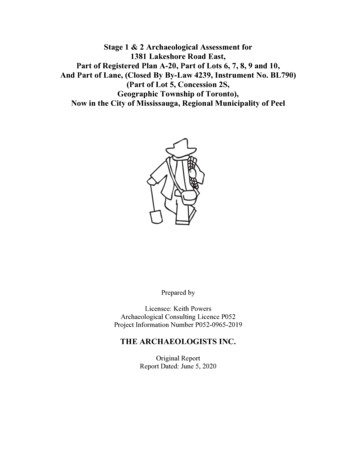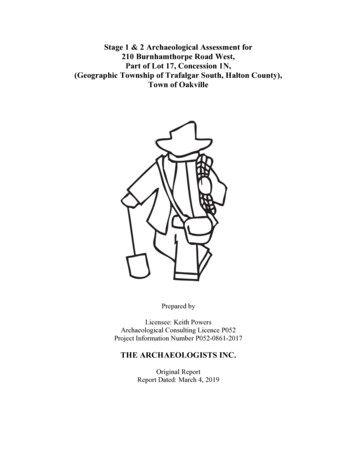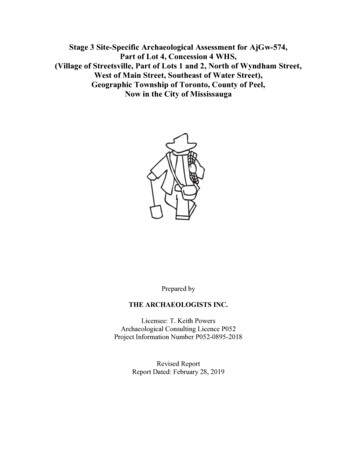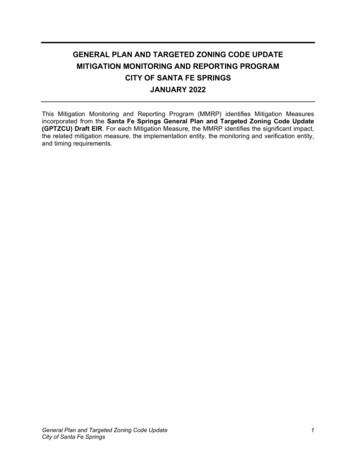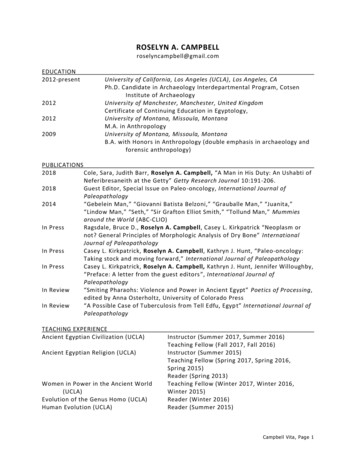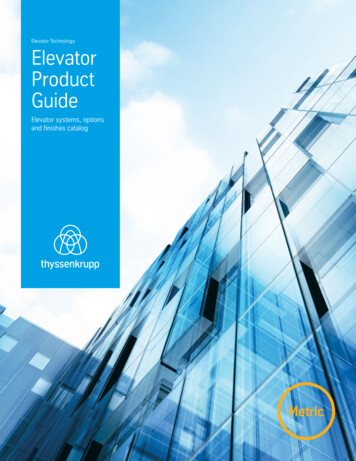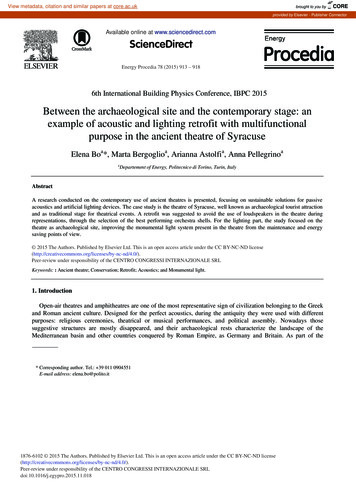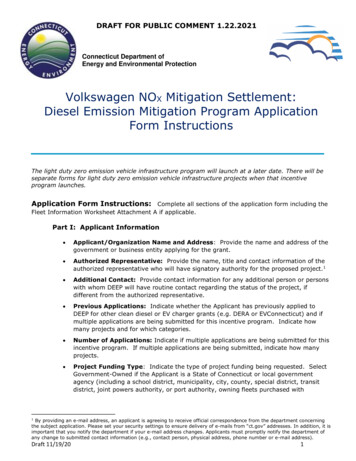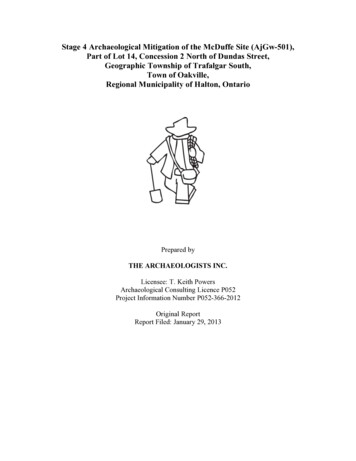
Transcription
Stage 4 Archaeological Mitigation of the McDuffe Site (AjGw-501),Part of Lot 14, Concession 2 North of Dundas Street,Geographic Township of Trafalgar South,Town of Oakville,Regional Municipality of Halton, OntarioPrepared byTHE ARCHAEOLOGISTS INC.Licensee: T. Keith PowersArchaeological Consulting Licence P052Project Information Number P052-366-2012Original ReportReport Filed: January 29, 2013
EXECUTIVE SUMMARYThe Archaeologists Inc. was contracted to conduct a Stage 4 archaeological mitigation ofof the Euro-Canadian McDuffe Site (AjGw-501), located within Part of Lot 14,Concession 2 North of Dundas Street, Geographic Township of Trafalgar, Town ofOakville, Regional Municipality of Halton. The assessment was conducted in advance ofsubmission of a draft plan of subdivision for Star Oaks Development Limited. Thearchaeological assessment was triggered by the Planning Act.The McDuffe Site (AjGw-501) was discovered by pedestrian survey during a Stage 1-2assessment of the subject property by The Archaeologists Inc. (TAI 2008). The site wasidentified as a mid-nineteenth century Euro-Canadian scatter. The presence of tablewares,and architectural artifacts suggested that the site represents a Euro-Canadian homesteadwith an occupation date range between 1830-1860. The site was identified as apotentially significant archaeological resource and it was recommended for Stage 3 sitespecific archaeological assessment.The Stage 3 assessment of the site began with a controlled surface collection (CSP) andresulted in the recovery of 164 surface artifacts. Test unit excavation resulted in theexcavation of 72 test units and the recovery of 353 artifacts. No cultural features ormidden areas were identified. Given that most of the time span of occupation of thearchaeological site appears to date before 1870, it is recommended that the site hasfurther cultural heritage value or interest, and should be subject to Stage 4 mitigation. Asavoidance and protection is not a viable option, the report recommends that the site besubject to Stage 4 excavation following the strategy for sites that mostly date to after1830 as per Standard 2, Section 4.2.7 of the 2011 Standards and Guidelines forConsultant Archaeologists.The Stage 4 excavation of the site was conducted by mechanical topsoil removal as perStandard 2, Section 4.2.7 of the 2011 Standards and Guidelines for ConsultantArchaeologists. The exposed subsoil surface was cleaned by shovel and trowel to aid inidentifying any subsurface cultural features. A total of one cultural feature was identified.The feature is identified as a possible shed or storage structure with an ancillary drain.Both were excavated in their entirety and all features fills were screened through 6 mmmesh. The recovered artifact assemblage includes ceramic, glass and metal artifacts.Ceramic tablewares recovered indicate a date range from the 1830s through to the 1860s.The McDuffe (AiGw-501) site has been completely excavated and has no further culturalheritage value or interest.i
TABLE OF CONTENTSExecutive SummaryTable of ContentsProject Personnel1.0 Project Context1.1 Development Context1.2 Historical Context1.3 Archaeological Context2.0 Field Methods3.0 Record of Finds4.0 Analysis and Conclusions5.0 Recommendations6.0 Advice on Compliance with Legislation7.0 Bibliography and Sources8.0 Images9.0 MapsAPPENDIX A: CATALOGUEiiiiii11236811121314162027ii
PROJECT PERSONNELProject/Field Director:Mr. T. Keith Powers (P052)Field ArchaeologistsMr. T. Keith PowersMr. Barclay PowersMr. John EllisMr. Sam FilipeReport Preparation:Mr. Norbert StanchlyGraphicsMrs. Karen PowersMr. T. Keith PowersMr. Norbert Stanchlyiii
Stage 4 Archaeological Mitigation of the McDuffe Site (AjGw-501), Part of Lot 14, Concession 2 North ofDundas Street, Geographic Township of Trafalgar South, Town of Oakville, Regional Municipality ofHalton, OntarioINTRODUCTIONThe Ontario Heritage Act requires licensees to report on archaeological fieldwork doneunder their licence. Section 65 sets out reporting requirements for licensees. When sorequired by the Minister, a licensee shall file with the Minister a report, containing fulldetails of work done under the licence and such other information as the Minister mayrequire. When so required by the Minister, a person, organization or corporation shallprepare and file with the Minister particulars of all property of archaeological orhistorical significance in Ontario, known to such person, organization or corporation. Areport and particulars shall be filed with the Minister in such form and manner as theMinister may require.The project report is a summary of the archaeological fieldwork carried out. It includesthe background research, description of archaeological fieldwork, fieldwork decisionmaking, artifact analysis and documentation, assessment of potential impacts andconclusions and recommendations.1.0PROJECT CONTEXT (Section 7.5.5)This section of the report will provide the context for the archaeological fieldwork,including the development context, the historical context, and the archaeological context.1.1 Development Context (Section 7.5.6, Standards 1-3)Section 7.5.6, Standard 1The Archaeologists Inc. was contracted to conduct a Stage 4 archaeological mitigation ofof the Euro-Canadian McDuffe Site (AjGw-501), located within Part of Lot 14,Concession 2 North of Dundas Street, Geographic Township of Trafalgar, Town ofOakville, Regional Municipality of Halton. The assessment was conducted in advance ofsubmission of a draft plan of subdivision for Star Oaks Development Limited. Thearchaeological assessment was triggered by the Planning Act.Section 7.5.6, Standard 2There is no additional development-related information relevant to understanding thechoice of fieldwork strategy or recommendations made in the report.Section 7.5.6, Standard 3Permission to access the study area to conduct all required archaeological fieldworkactivities, including the recovery of artifacts was given by the landowner and theirrepresentative.1
Stage 4 Archaeological Mitigation of the McDuffe Site (AjGw-501), Part of Lot 14, Concession 2 North ofDundas Street, Geographic Township of Trafalgar South, Town of Oakville, Regional Municipality ofHalton, Ontario1.2 Historical Context (Section 7.5.7, Standards 1-2)Section 7.5.7, Standard 1In advance of the Stage 4 excavation, a Stage 1 background study of the subject propertyand Stage 2 archaeological assessment was conducted by The Archaeologists Inc. (TAI2008). The Stage 2 archaeological assessment consisted of a systematic pedestrian surveyof the subject property during the course of which Site AjGw-501 was discovered. Thesite consisted of an artifact scatter within an agricultural field of approximately 200artifacts distributed over an area of approximately 20 metres by 30 metres.The retained diagnostic artifacts suggested that the deposit fits into a date range ofbetween 1830’s-1860’s. The presence of red and blue transfer printed wares, bluespongeware, floware, transferprints, are indicative of an historic deposit that falls withinthe second and third quarter of the 19th century. The presence of kitchen tablewares andarchitectural items suggested that the site represents a Euro-Canadian homestead.According to the 1877 Historical Atlas of the County of Halton Lot 14, Concession 2North of Dundas Street, was owned by “Dan McDuffe”. The Atlas depicts a singlestructure within the subject property in the approximate location of Site AjGw-501.Settlement commenced in Trafalgar Township around 1807. By 1817 the township had apopulation of 548 and contained one grist mill and four saw mills. The populationreached 4,513 by 1850 and, according to the census, had jumped to 5,027 in 1871. This1871 total did not include the towns of Oakville and Milton which had been separatesince 1850 (Illustrated Historical Atlas of the County of Halton 1877).A search of material at the Ontario Archives has revealed the following informationregarding the development of Lot 14, Concession 2, NDS. According to the AbstractIndex to Deed Titles the Crown Patent was granted to Jason McDuffe in 1818. The patentwas for all 200 acres. McDuffe is listed as a landowner in 1821.Jason McDuffe is enumerated in the 1851 personal census. He was a 26 year old Scottishborn farmer who lived with his wife Elizabeth, and two sons. The family lived in a oneand a half story frame dwelling [AO, Microfilm of 1851 Census Rolls, TrafalgarTownship, reel C-11724]. A Daniel McDuffe is listed in the 1861 census. He was a 48year old farmer who lived with his wife and their three children. The family possessed200 acres, of which 100 were cultivated. The farm’s crops included wheat, barley, rye,peas, oats, buckwheat, and potatoes, and the livestock included cows, sheep, and pigs.The family lived in a one and a half storey frame dwelling that was built in 1836 [AO,Microfilm of 1861 Census Rolls, Trafalgar Township, reel C-1030].The 1884 assessmentnoted D. McDuffe as the freeholder and Seamus McDuffe as the tenant [AO, Microfilmof Assessment Rolls, Trafalgar Township, reel MS 52/5].It would appear that the McDuffe family owned this lot throughout the entire nineteenthcentury. According to the census and assessments, they occupied a one and a half storeyframe building that was built either in the late 1830s or early 1840s. By the mid-1870s,2
Stage 4 Archaeological Mitigation of the McDuffe Site (AjGw-501), Part of Lot 14, Concession 2 North ofDundas Street, Geographic Township of Trafalgar South, Town of Oakville, Regional Municipality ofHalton, Ontariothis home had been replaced and was occupied by tenants during the last quarter of thenineteenth century.To summarize, the historical background records indicate that Site AjGw-501 may berelated to the initial occupation of the lot by the McDuffe family in the late 1830s through1860s and beyond. The recovered artifacts suggest that the site is related to the earliestoccupation of the subject property soon after the arrival of the McDuffe family.Section 7.5.7, Standard 2The fieldwork strategy for the Stage 4 excavation of the site follows that recommended inthe Stage 3 archaeological assessment report prepared by Mr. T. Keith Powers of TheArchaeologists Inc. (PIF P052-363-2012). The site was identified as an archaeologicalsite that mostly dates to after 1830 with no identified midden deposits. The reportrecommended that the Stage 4 excavation of the should begin with mechanical topsoilremoval as per Standard 2, Section 4.2.7 of the 2011 Standards and Guidelines forConsultant Archaeologists. The exposed subsoil surface should then be cleaned by shoveland trowel to aid in identifying any subsurface cultural features. Mechanical topsoilremoval must extend a minimum of 10 m beyond uncovered cultural features. Featureexcavation must follow all relevant standards as per Sections 4.2.7 and 4.2.2 of the 2011Standards and Guidelines for Consultant Archaeologists. In addition, all cultural featuresshould be excavated by hand and all features must be documented with photographs anddrawings including plans and profiles of those cultural features.1.3 Archaeological Context (Section 7.5.8, Standards 1-7)Section 7.5.8, Standard 1Information on the known archaeological sites in the vicinity of the study area wasobtained form the Ministry of Tourism, Culture & Sport site database. Prior to thediscovery of the site, 16 registered archaeological sites within a minimum one kmdistance from the project limits were known (Table 1).TABLE 1: Registered Archaeological Sites Within 1 kilometre of the Study AreaBorden -427AiGw-433Site NameLernanLandingCultural AffiliationUndetermined PrecontactUndetermined PrecontactUndetermined PrecontactUndetermined PrecontactUndetermined PrecontactEarly WoodlandUndetermined PrecontactEuro-CanadianUndetermined PrecontactUndetermined PrecontactUndetermined PrecontactEuro-CanadianArchaicUndetermined PrecontactSite adCampsiteFindspotResearcher(s)Pearce, 1984Pearce, 1984Pearce, 1984Pearce, 1984Pearce, 1984ASI, 2006ASI, 2006ASI, 2006ASI, 2006ASI, 2006ASI, 2006ASI, 1992Slocki, 2004Slocki, 20043
Stage 4 Archaeological Mitigation of the McDuffe Site (AjGw-501), Part of Lot 14, Concession 2 North ofDundas Street, Geographic Township of Trafalgar South, Town of Oakville, Regional Municipality ofHalton, OntarioAjGw-434AiGw-28Undetermined PrecontactUndetermined PrecontactFindspotFindspotSlocki, 2004Phil; 1980Section 7.5.8, Standard 2The study area is situated in the South Slope physiographic region in close proximity tothe Peel Plain physiographic region, (located south of the study area). The South Slopephysiographic region is characterized by gently rolling till plains at a height ofapproximately 245 metres above sea level, descending southward toward Lake Ontarioand ending, in some areas, at elevations below 150 metres above sea level. Numerousrivers and streams descend the Slope, having cut deep valleys in the till (Chapman andPutnam 1984:175). The McDuffe Site is located within active cultivated field on fairlylevel terrain.Section 7.5.8, Standard 3The Stage 4 fieldwork was undertaken between June 27 and July 4, 2012.Section 7.5.8, Standards 4 and 5Site AjGw-501 was originally identified during a Stage 1 and 2 assessment of the subjectproperty by The Archaeologists Inc (TAI 2008). The Stage 1 background studyconcluded that the property exhibits archaeological potential. A Stage 2 propertyassessment was conducted to document all archaeological resources on the property, todetermine whether the property contains archaeological resources requiring furtherassessment, and to recommend next steps. The site was discovered during a pedestriansurvey. The Stage 2 assessment also resulted in the discovery of the Bigger Site (AjGw500), located adjacent to the McDuffe site, in Lot 14, Concession 2. Both sites wereconsidered to be of further cultural heritage value and Stage 3 site-specific assessmentwas recommended for both sites. The Bigger Site was subject to a Stage 3 site-specificassessment by The Archaeologists Inc. under PIF P052-362-2012.The McDuffe Site (AjGw-501) was discovered by pedestrian survey during a Stage 1-2assessment of the subject property by The Archaeologists Inc. The site was identified as amid-nineteenth century Euro-Canadian scatter. The presence of tablewares, andarchitectural artifacts suggested that the site represents a Euro-Canadian homestead withan occupation date range between 1830-1860. The site was identified as a potentiallysignificant archaeological resource and it was recommended for Stage 3 site-specificarchaeological assessment.The Stage 3 assessment of the site began with a controlled surface collection (CSP) andresulted in the recovery of 164 surface artifacts. Test unit excavation resulted in theexcavation of 72 test units and the recovery of 353 artifacts. No cultural features ormidden areas were identified. Given that most of the time span of occupation of thearchaeological site appears to date before 1870, it is recommended that the site hasfurther cultural heritage value or interest, and should be subject to Stage 4 mitigation. Asavoidance and protection is not a viable option, the report recommends that the site besubject to Stage 4 excavation following the strategy for sites that mostly date to after4
Stage 4 Archaeological Mitigation of the McDuffe Site (AjGw-501), Part of Lot 14, Concession 2 North ofDundas Street, Geographic Township of Trafalgar South, Town of Oakville, Regional Municipality ofHalton, Ontario1830 as per Standard 2, Section 4.2.7 of the 2011 Standards and Guidelines forConsultant Archaeologists.The types of artifacts identified during the Stage 3 assessment include diagnostics that fitinto a date range within the second and third quarter of the 19th century (i.e. 1830-1860s).This is based on the recovery of diagnostic ceramics, metal and glass. Diagnostic ceramictypes include red, blue, black, and green transferprint, blue scalloped and bluespongeware, late-palette hand painted, blue floware, and plain refined white earthenware.Red earthenware crockery was also noted.Metal artifacts include machine cut nails and some indeterminate fragments likelyassociated with farm equipment. Glass items include thin window glass, bottle glass (e.g.olive green, clear, amber), and container glass. Small amounts of faunal bone was alsorecovered. Brick fragments were noted but not retained. None of the brick fragmentswere diagnostic. In summary, the artifact assemblage includes those items one wouldexpect related to a homestead occupation involved in farming.The report recommended that the Stage 4 excavation should begin with mechanicaltopsoil removal as per Standard 2, Section 4.2.7 of the 2011 Standards and Guidelinesfor Consultant Archaeologists. The exposed subsoil surface should then be cleaned byshovel and trowel to aid in identifying any subsurface cultural features. Mechanicaltopsoil removal must extend a minimum of 10 m beyond uncovered cultural features.Feature excavation must follow all relevant standards as per Sections 4.2.7 and 4.2.2 ofthe 2011 Standards and Guidelines for Consultant Archaeologists. In addition, all culturalfeatures should be excavated by hand and all features must be documented withphotographs and drawings including plans and profiles of those cultural features. Alldocumentation must include scales and north orientation. Features fills must be screenedthrough 6 mm mesh. If root cellars or privies are identified, soil samples must becollected from each quadrant or stratum, respectively. Artifact documentation andanalysis must follow all relevant standards as per Section 6.0 of the 2011 Standards andGuidelines for Consultant ArchaeologistsThe Stage 4 excavation did not differ from the above recommendations or standards.Section 7.5.8, Standard 6There are no unusual physical features that may have affected fieldwork strategydecisions or the identification of artifacts or cultural features.Section 7.5.8, Standard 7There is no additional archaeological information that may be relevant to understandingthe choice of fieldwork techniques or the recommendations of this report other than thatprovided above.5
Stage 4 Archaeological Mitigation of the McDuffe Site (AjGw-501), Part of Lot 14, Concession 2 North ofDundas Street, Geographic Township of Trafalgar South, Town of Oakville, Regional Municipality ofHalton, Ontario2.0 FIELD METHODS (Section 7.11.1, Standard 1)This section of the report addresses Section 7.11.1 of the 2011 Standards and Guidelinesfor Consultant Archaeologists.Section 7.11.1, Standard 1aAll fieldwork was conducted according to the relevant archaeological fieldwork standardsand guidelines as per Sections 4.2.1, 4.2.3, and 4.2.7 of the 2011 Standards andGuidelines for Consultant Archaeologists. All fieldwork Section 4.2.1, S1 – Not applicable as the site meets exceptions in Sections 4.2.3and 4.2.7 of the 2011 Standards and Guidelines for Consultant Archaeologists.Section 4.2.1, S2 – Before carrying out fieldwork, we reviewed all availablerelevant reports of previous fieldwork on the archaeological site or property.Section 4.2.1, S3 – The excavation was carried out when weather and lightingconditions permitted identification of subsurface cultural features and saferecovery of artifacts.Section 4.2.1, S4 – The GPS coordinates for the location of the permanent datumis provided in the supplementary documentation.Section 4.2.1, S5 – The standard is not relevant as no units were excavated.Section 4.2.1, S6 – Feature fills were excavated stratigraphically.Section 4.2.1, S7 – All cultural features were excavated by hand.Section 4.2.1, S8 – All artifacts were retained for analysis in the lab.Section 4.2.1, S9 – All cultural features were documented with photographs anddrawings including plans and profiles. Scales and north orientation is included inall documentation.Section 4.2.1, S10 – n/aSection 4.2.1, S11 - All fieldwork was documented in sufficient detail, includingthe following: field notes, maps, and photographic records of all field methods,archaeological findings, and unusual or difficult situations encountered in thefield; and logs of photographic documentation, maps and graphics.Section 4.2.3, S1 – All of the conditions for this standard where met, in order toallow for mechanical topsoil removal of soil. The site had been subject toploughing for many years, the site has only one cultural stratum below topsoil, thesite is large ( 10 x 10 metres as defined in the 2011 Standards and Guidelines forConsultant Archaeologists), the cultural affiliation (i.e. 19th century EuroCanadian) gave rise to the reasonable expectation that extensive sub-surfacecultural features and settlement date will be present, and the Stage 2 and 3assessments had documented a representative sample of ploughzone artifacts andtheir distribution.Section 4.2.3, S2 – To avoid damage to the underlying archaeological site, weused a Gradall with a flat-edged bucket to pull soil away.Section 4.2.3, S3 – Mechanical topsoil removal stopped at the topsoil/subsoilinterface.6
Stage 4 Archaeological Mitigation of the McDuffe Site (AjGw-501), Part of Lot 14, Concession 2 North ofDundas Street, Geographic Township of Trafalgar South, Town of Oakville, Regional Municipality ofHalton, Ontario Section 4.2.3, S4 – At no time, did we allow exposed subsoil surfaces to dry outsuch that cultural features cannot be identified.Section 4.2.3, S5 – As mechanical topsoil removal did not affect the integrity ofcultural features, it was not necessary to switch to hand excavations.Section 4.2.3, S6 – We cleaned all exposed subsoil surfaces by shovel (“shovelshine”) or trowel following mechanical topsoil removal.Section 4.2.7, S1 – n/aSection 4.2.7, S2 – n/a as no midden areas were identified during the Stage 2 or 3assessments. Excavation proceeded immediately to mechanical topsoil removal.Section 4.2.7, S3 – We excavated each feature in its entirety, above and beyondthis standard.Section 4.2.7, S4 – There were no large or complex structural features.Section 4.2.7, S5 – n/aSection 7.11.1, Standard 1bThe GPS coordinates for the site datum location are provided in the supplementarydocumentation.Section 7.11.1, Standard 1cAs no hand excavations were conducted, this standard is not relevant.Section 7.11.1, Standard 1dThe method used to remove topsoil, as mentioned several times already, was mechanicalusing a Gradall equipped with a flat bucket to pull soil away. This was monitoried by Mr.Keith Powers at all times. The methods followed those as per section 4.2.3 as discussedabove. Topsoil removal extended a minimum of 10 metres beyond all identified culturalfeatures.Section 7.11.1, Standard 1eNot applicable as the site was excavated in its entirety.Section 7.11.1, Standard 1fThe extent of mechanical topsoil removal and the location of all cultural features wasmapped with the aid of a total station in relation to the established datum and grid.Artifacts were bagged and recorded to specific provenience (i.e. feature number andlevel). Feature plans and profiles were photographed using a digital camera and weremapped at either 1:10 or 1:20 scale following basic archaeological field techniques.7
Stage 4 Archaeological Mitigation of the McDuffe Site (AjGw-501), Part of Lot 14, Concession 2 North ofDundas Street, Geographic Township of Trafalgar South, Town of Oakville, Regional Municipality ofHalton, Ontario3.0 RECORD OF FINDS (Section 7.11.2, Standards 1-5)Section 7.11.2, Standard 1One cultural feature was identified during the Stage 4 excavation. This has beendesignated Feature 1.Feature 1This feature was rectangular in plan view and measured approximately 2.6 metres by1.62 metres and was excavated to subsoil at a maximum depth of 28 centimetres. Thebase of the feature was generally flat bottomed and one wall of feature had red claybricks. It could not be determined if the bricks represented a lining for the feature or not.Feature fill consisted of a single mottled layer of dark brown organic soil with charcoaland clay brick inclusions. The fill was screened using 6mm mesh, resulting in therecovery of an artifact assemblage which included ceramic, metal and glass artifacts ofthe architectural and kitchen-food class. Faunal remains were also recovered. The featureis likely the remnants of a small structure. There appears to be a small remnant drainlocated on its northeast corner.A total of 101 artifacts (including faunal remains) was recovered from feature fill. Theceramics collected are representative of an early-to-late nineteenth-century southernOntario assemblage. The most numerous type of ceramic in the assemblage is RWE,which was the ware that came into common use in Ontario by 1835, replacing earlierwares such as pearlware (Kenyon 1995). Decorations found in the RWE assemblageconsist of spongeware, floware and transfer print as well as hand painted motifs. Thespongeware and floware decorations date to 1845-1870 while the hand painted latepalette and transfer print fragments date from 1830-1870 (Kenyon 1995). Red coarseearthenware was also collected and was manufactured in the mid-to-late nineteenthcentury through to the twentieth century. Overall, the assemblage dates from the earlynineteenth-century through to the mid to late nineteenth-century, i.e. ca. 1830s-1860s.The glass assemblage consists of colourless, aqua, and olive green glass. Machine cutnails and various scrap and unidentified metal fragments were also collected. Machinecut nails were introduced in Ontario in the second quarter of the nineteenth century andbegin to fall out of use in the last quarter of the nineteenth century, when they werereplaced by wire nails.Section 7.11.2, Standard 2Not applicable.Section 7.11.2, Standard 3Feature 1 is likely the remnant of a small structure, possibly a storage structure or shed,given its size. Attached to the structure is a stone lined drain measuring approximately 9metres long with a width of approximately 50cm. The lack of any other featuresassociated with a homestead suggests that if a structure did exist, it was built from8
Stage 4 Archaeological Mitigation of the McDuffe Site (AjGw-501), Part of Lot 14, Concession 2 North ofDundas Street, Geographic Township of Trafalgar South, Town of Oakville, Regional Municipality ofHalton, Ontarioperishable materials and its remnants were likely removed and destroyed by excessiveploughing.Section 7.11.2, Standard 4As discussed above, a total of 101 artifacts (including faunal remains) was recoveredfrom feature fill. The ceramics collected are representative of an early-to-late nineteenthcentury southern Ontario assemblage. The most numerous type of ceramic in theassemblage is RWE, which was the ware that came into common use in Ontario by 1835,replacing earlier wares such as pearlware (Kenyon 1995). Decorations found in the RWEassemblage consist of spongeware, floware and transfer print as well as hand paintedmotifs. The spongeware and floware decorations date to 1845-1870 while the handpainted late palette and transfer print fragments date from 1830-1870 (Kenyon 1995).Red coarse earthenware was also collected and was manufactured in the mid-to-latenineteenth-century through to the twentieth century. Overall, the assemblage dates fromthe early nineteenth-century through to the mid to late nineteenth-century, i.e. ca. 1830s1860s.The glass assemblage consists of colourless, aqua, and olive green glass. Machine cutnails and various scrap and unidentified metal fragments were also collected. Machinecut nails were introduced in Ontario in the second quarter of the nineteenth century andbegin to fall out of use in the last quarter of the nineteenth century, when they werereplaced by wire nails.The faunal assemblage was analyzed by Mr. Norbert Stanchly of AS&G ArchaeologicalConsulting. The faunal assemblage consisted of 11 bone fragments. All but one areunidentifiable large mammal fragments, likely from either cow or swine. The singleidentifiable bone is a right astragalus from a cow. No burning, butchering marks or othermodifications was noted on any of the bones.Please see Appendix A for a complete catalogue of all retained artifacts. These representitems related to the following classes of materials: kitchen/foodways, architectural,tools/equipment, following the Canadian Parks Service (1992). The catalogue andartifact description below follow the requirements regarding artifact analysis anddescription as per Section 6.0 – Artifact Documentation and Analysis, 2011 Standardsand Guidelines for Consultant Archaeologists. Section 6, Standard 1 - Formal artifact typologies follow the "ClassificationSystem for Historical Collections" (Canadian Parks Service 1992), The ParksCanada Glass Glossary (Jones and Sullivan 1989), and articles by Ian Kenyon(1980, 1995) and J.K. Jouppien (1980). Citations provided in report Section 7.0.Section 6, Standard 4 – There were no unstable artifacts.Section 6, Standard 5 – There were no large assemblages of unstable artifacts.Section 6, Standard 6 - see Appendix A for the artifact catalogue. The catalogueconforms to Standards 6a-6d.9
Stage 4 Archaeological Mitigation of the McDuffe Site (AjGw-501), Part of Lot 14, Concession 2 North ofDundas Street, Geographic Township of Trafalgar South, Town of Oakville, Regional Municipality ofHalton, Ontario Section 6, Standard 7 - The packed collection consists of a single banker box ofartifacts. The long-term curation plan is to store the artifacts at the laboratoryfacilities of The Archaeologists Inc.Section 6, Standard 8 - Sampling was not conducted.Section 7.11.2, Standard 5Provide an inventory of the documentary rec
the Stage 3 archaeological assessment report prepared by Mr. T. Keith Powers of The Archaeologists Inc. (PIF P052-363-2012). The site was identified as an archaeological site that mostly dates to after 1830 with no identified midden deposits. The report recommended that the Stage 4 excavation of the should begin with mechanical topsoil

